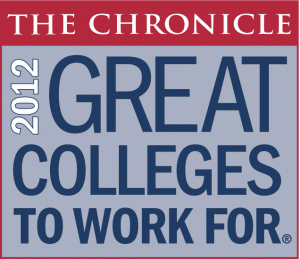Eastern Connecticut State University and Middlesex Community College were the only Connecticut institutions included among 103 college and universities nationwide named as Great Colleges to Work For in the latest annual survey by The Chronicle of Higher Education.
In an article accompanying the list of institutions, The Chronicle reported that “Open channels of communication, along with concrete ways of appreciating employees and helping them balance work and home, are hallmarks of great academic workplaces. At colleges, such policies have become more important as a slow national economy delays or shrinks raises.”
The Chronicle reported that the 2012 survey had the largest number of responses in its five-year history— about 47,000 college employees completed questionnaires, up from 44,000 in 2011. About 20,000 of the questionnaires this year were filled out by faculty, 8,500 by administrators, and nearly 18,000 by exempt professional staff. In all, participants represented 294 institutions. The survey was administered by ModernThink LLC in partnership with The Chronicle. The colleges and universities were analyzed in 12 categories, and submitted applications to be considered for the designation.
about 47,000 college employees completed questionnaires, up from 44,000 in 2011. About 20,000 of the questionnaires this year were filled out by faculty, 8,500 by administrators, and nearly 18,000 by exempt professional staff. In all, participants represented 294 institutions. The survey was administered by ModernThink LLC in partnership with The Chronicle. The colleges and universities were analyzed in 12 categories, and submitted applications to be considered for the designation.
Middlesex CC, with just under 3,000 students, was especially recognized for its compensation and benefits, with The Chronicle stating that “Paternity and maternity leaves can be as long as six months, and health-insurance coverage extends into retirement.” It is the first time that Middlesex has been included in The Chronicle’s list.
Eastern was recognized in three categories: collaborative governance, compensation and benefits, and facilities, workplace and security. The Chronicle noted that “The University Senate brings together executives, midlevel managers, and professors for twice-monthly meetings during the academic year. The president meets at least twice every semester with the leaders of the six campus unions.” Eastern was selected for the fourth consecutive year. The school has approximately 5,600 students.
Among the 103 institutions to receive the “Great College to Work For” designation, 42 were also selected for the “Honor Roll.” Neither Connecticut institution made that list.
 - compelling visuals, tables, animations to reveal the meaning of information – as well as data design and management, legislative tracking and analysis and opposition research for candidates.
- compelling visuals, tables, animations to reveal the meaning of information – as well as data design and management, legislative tracking and analysis and opposition research for candidates.




































